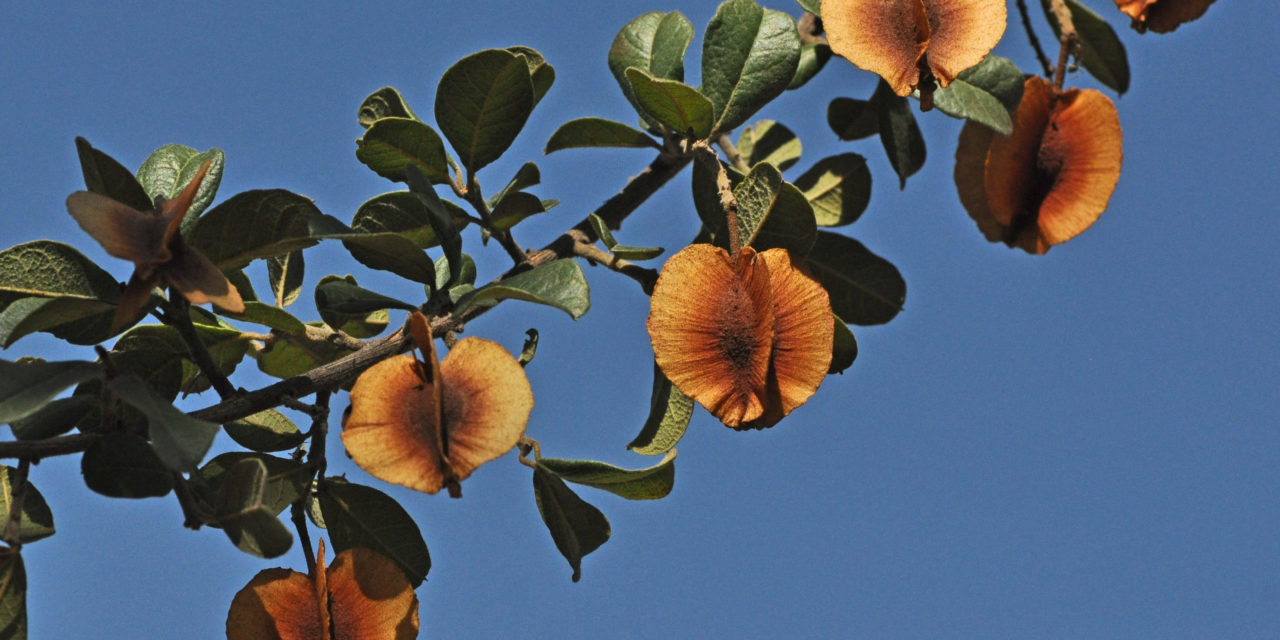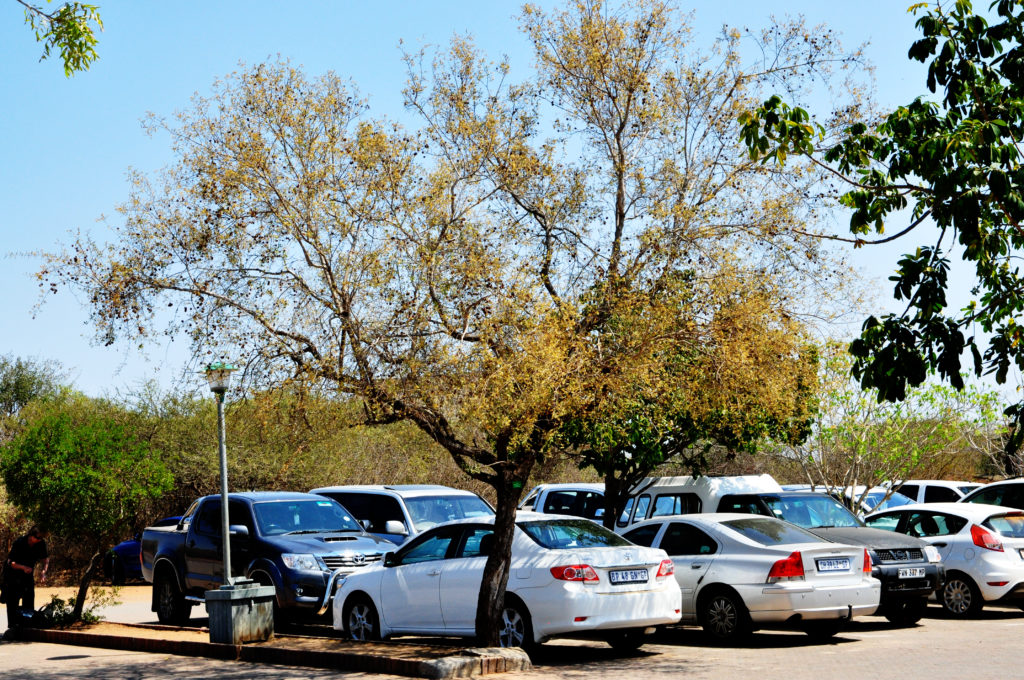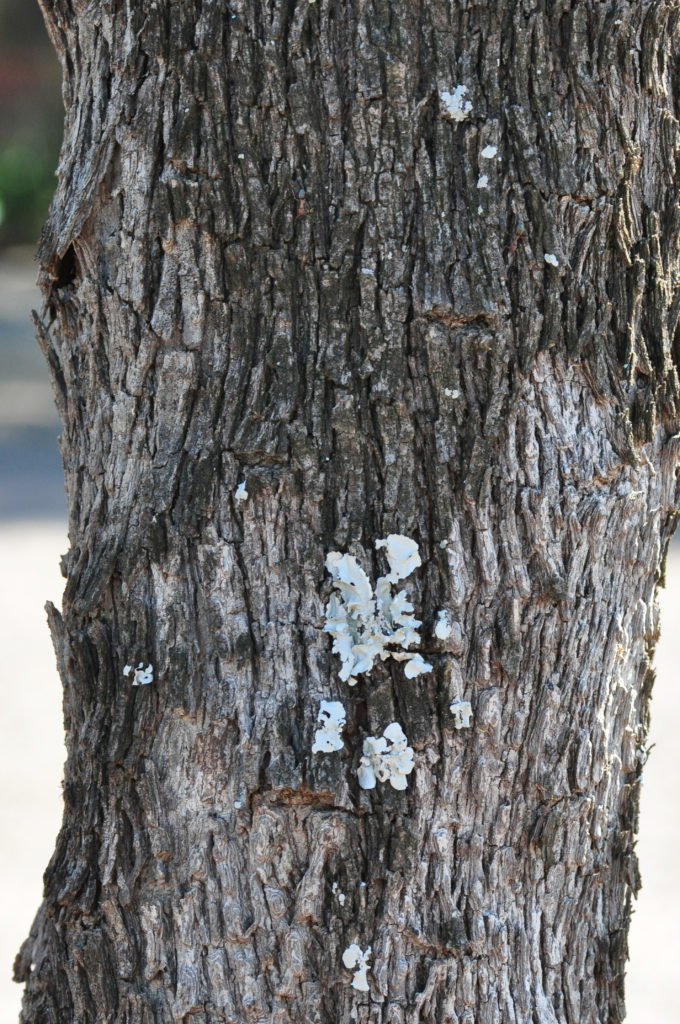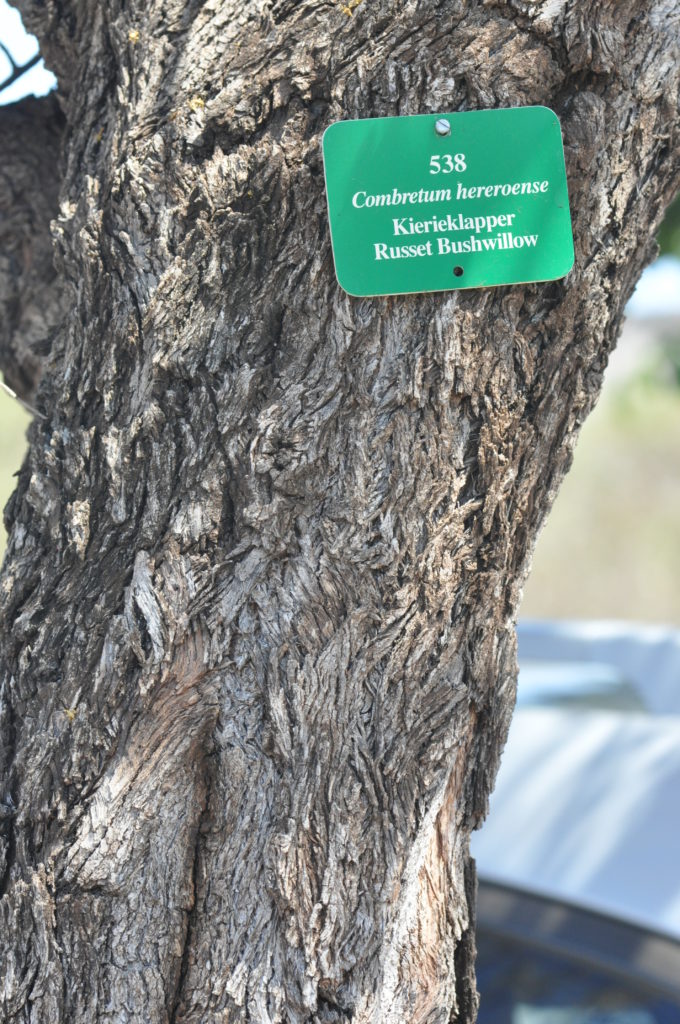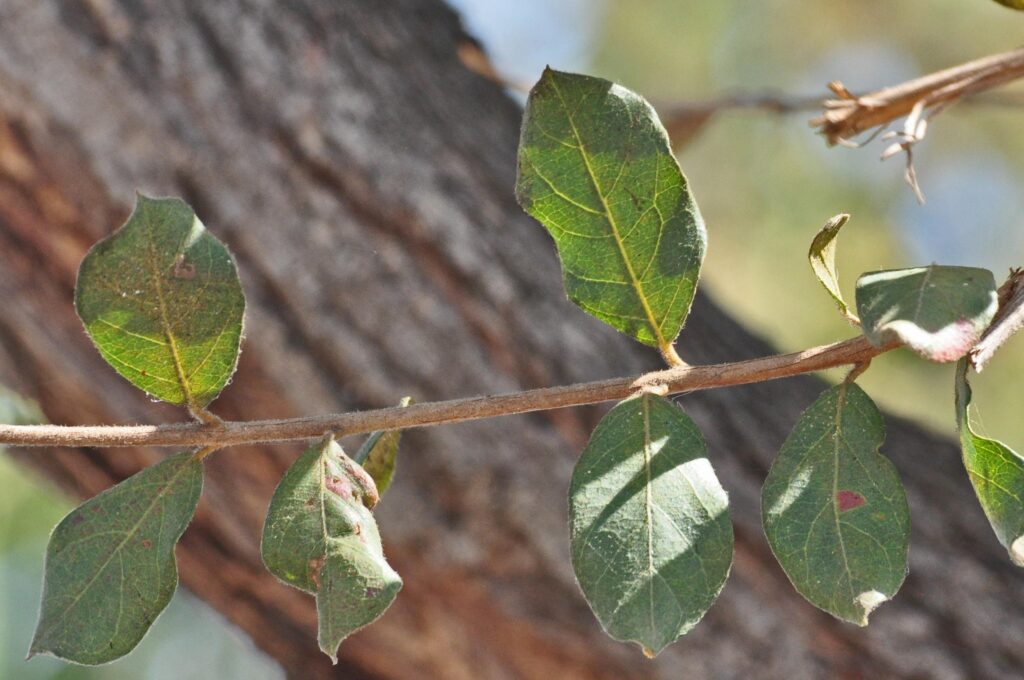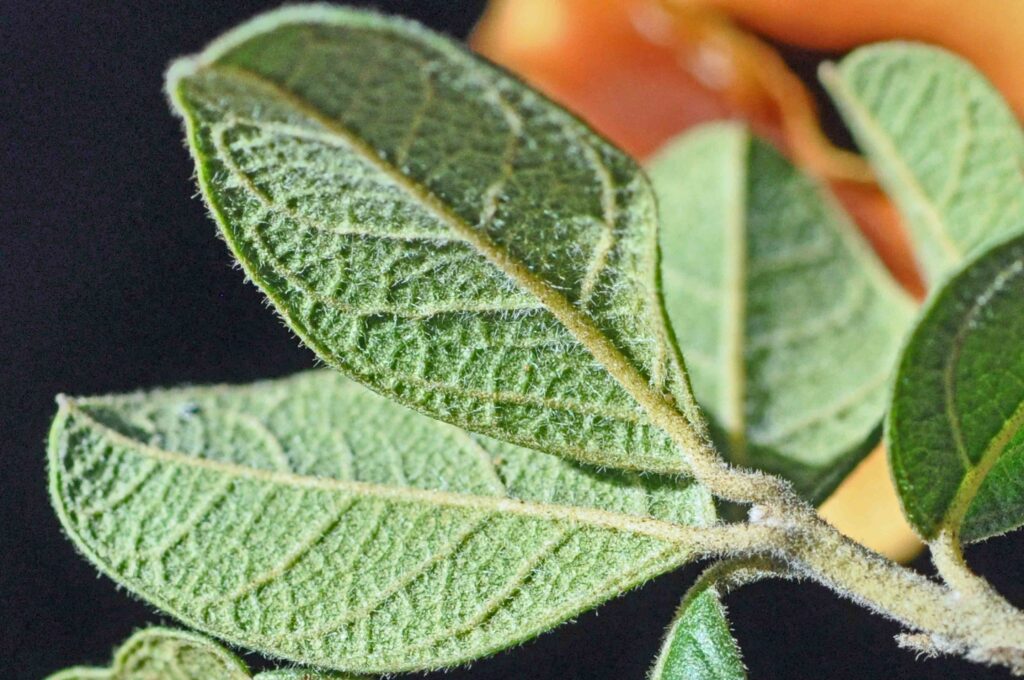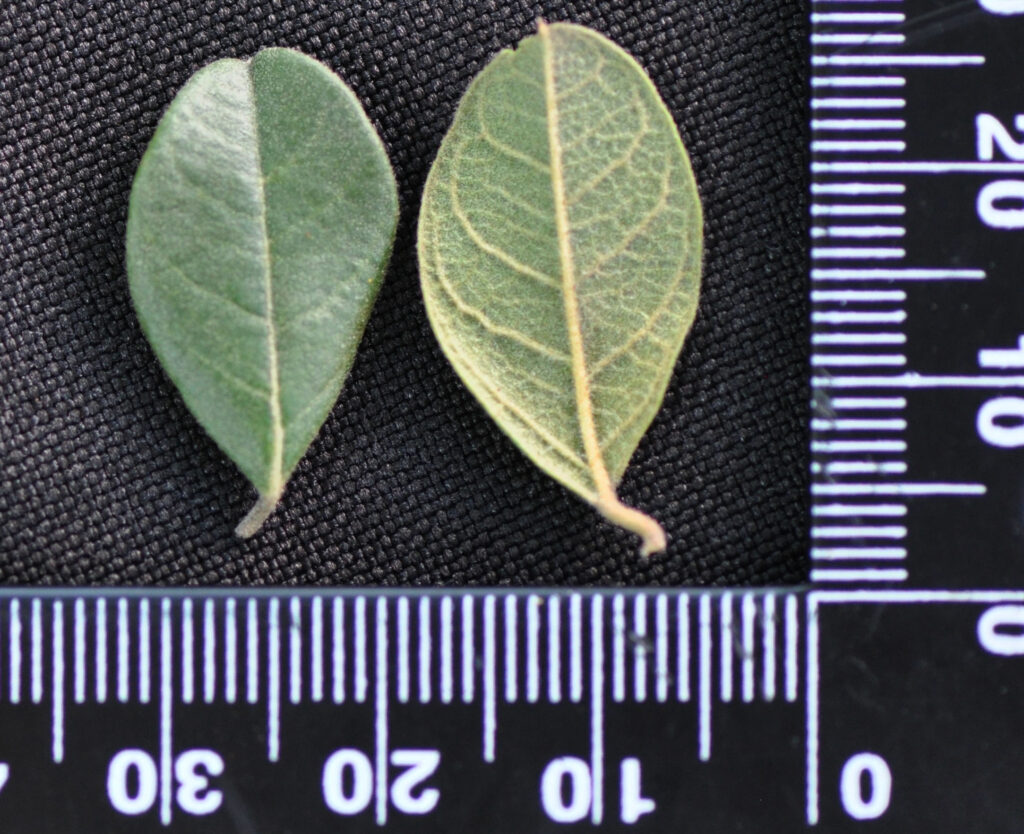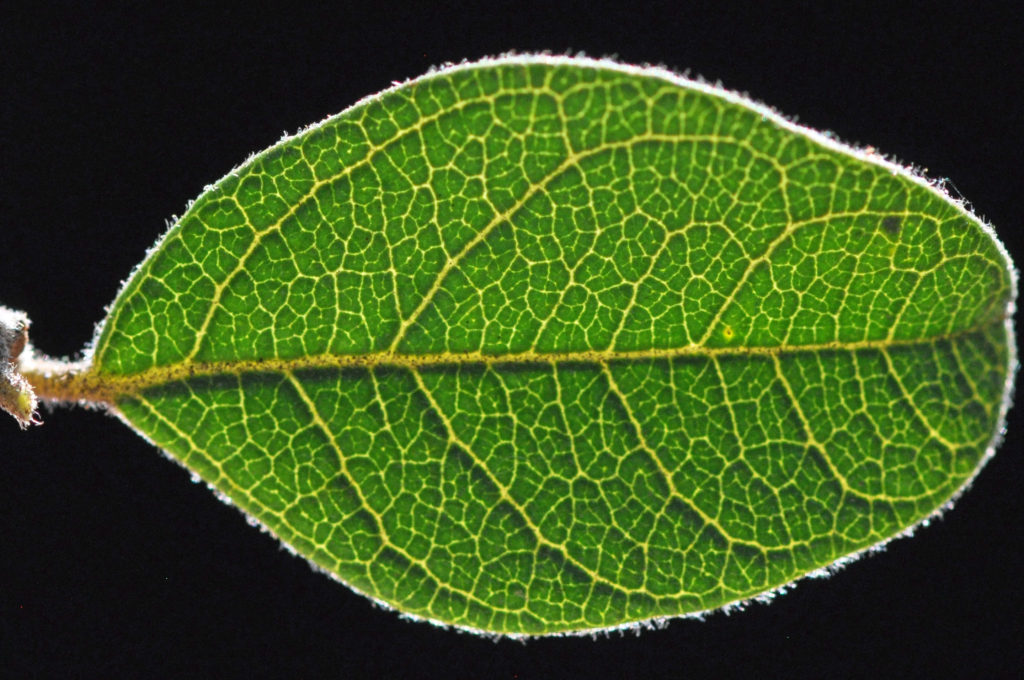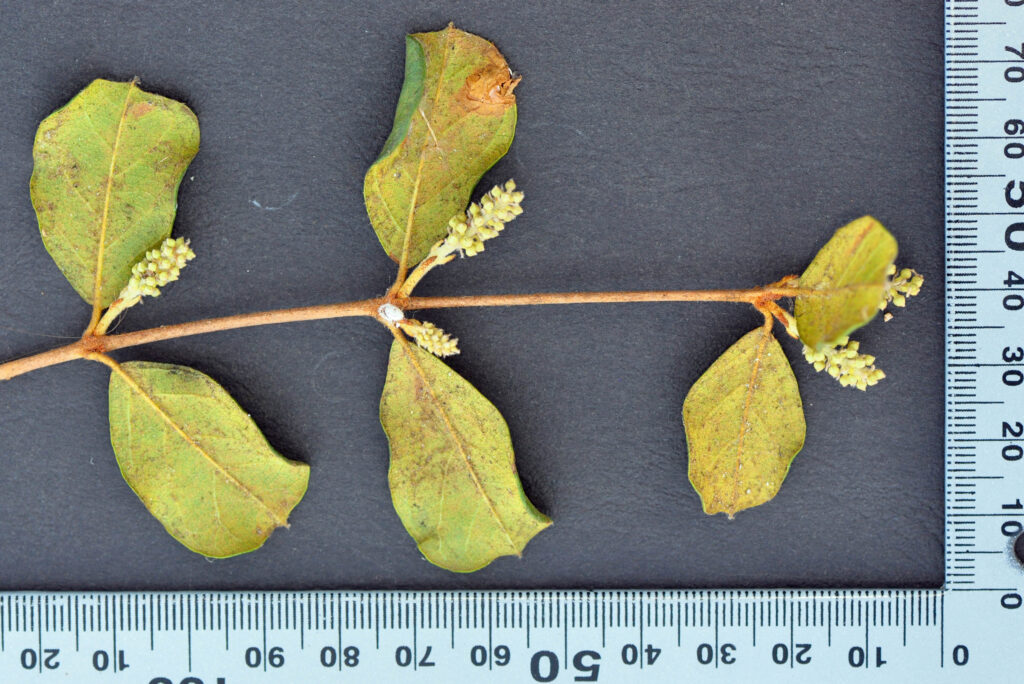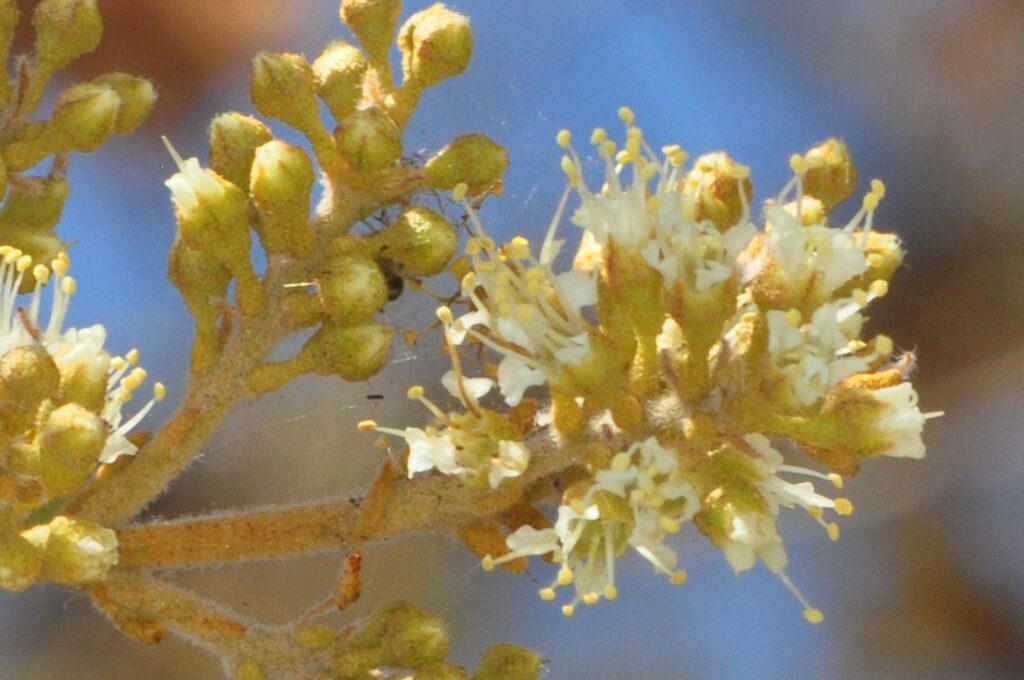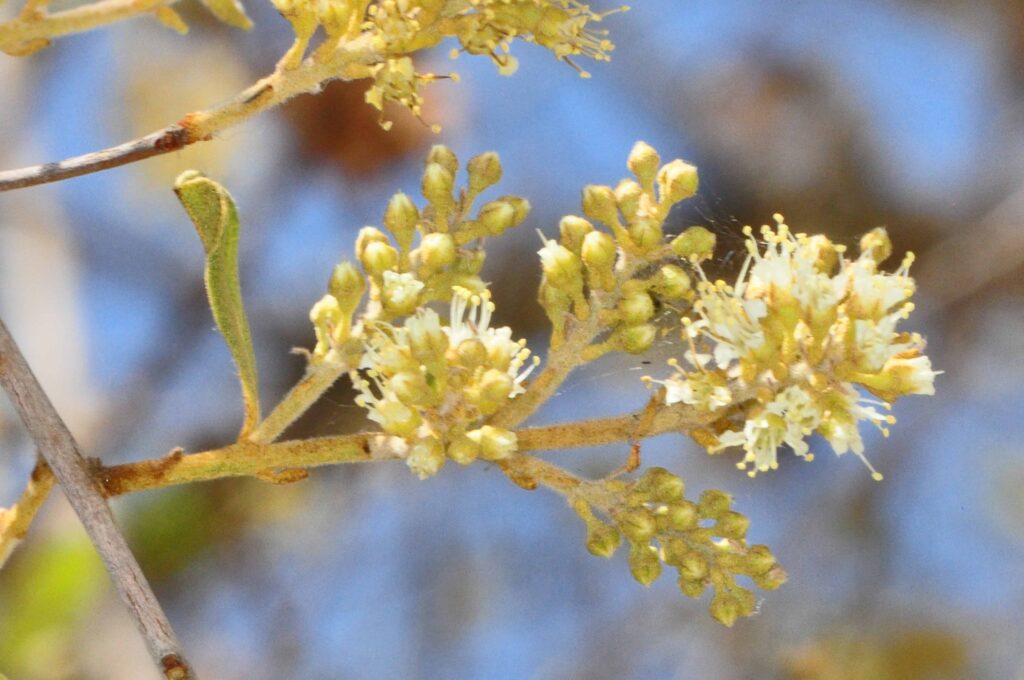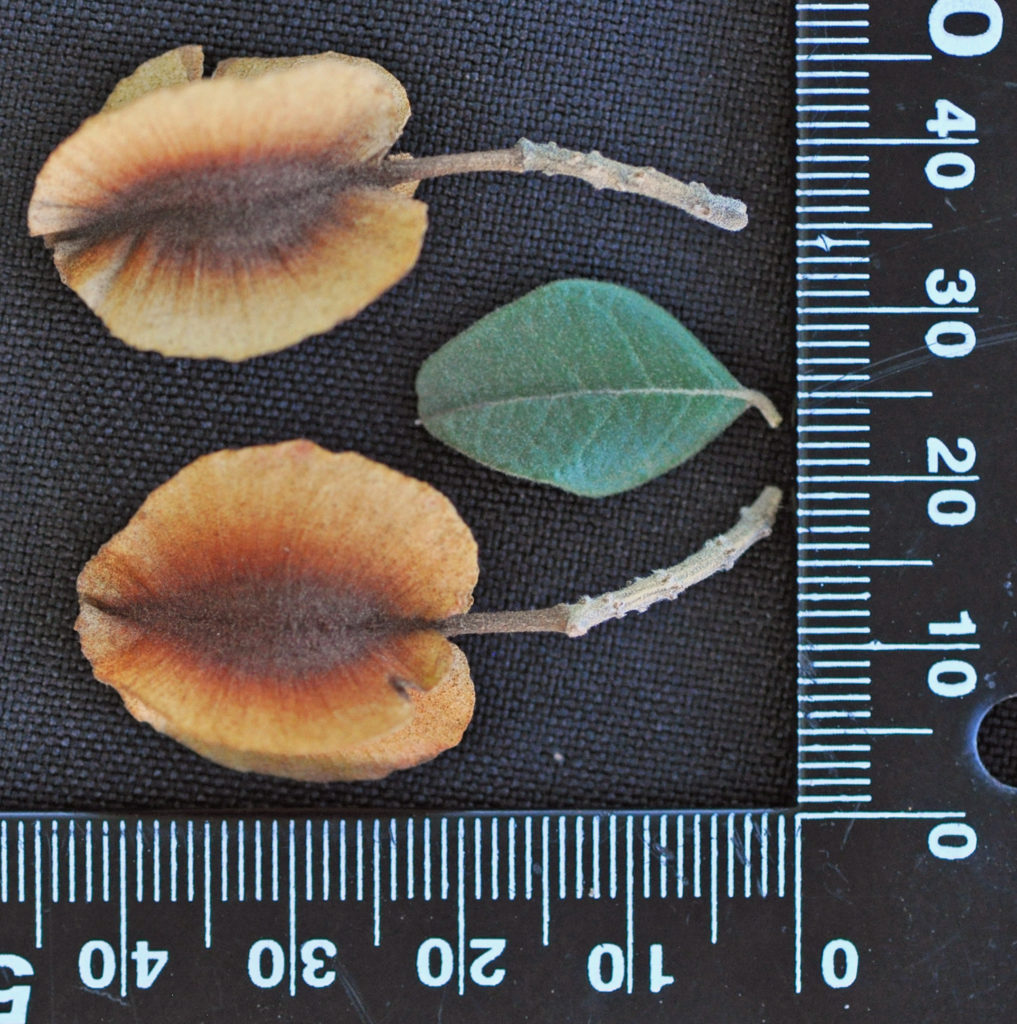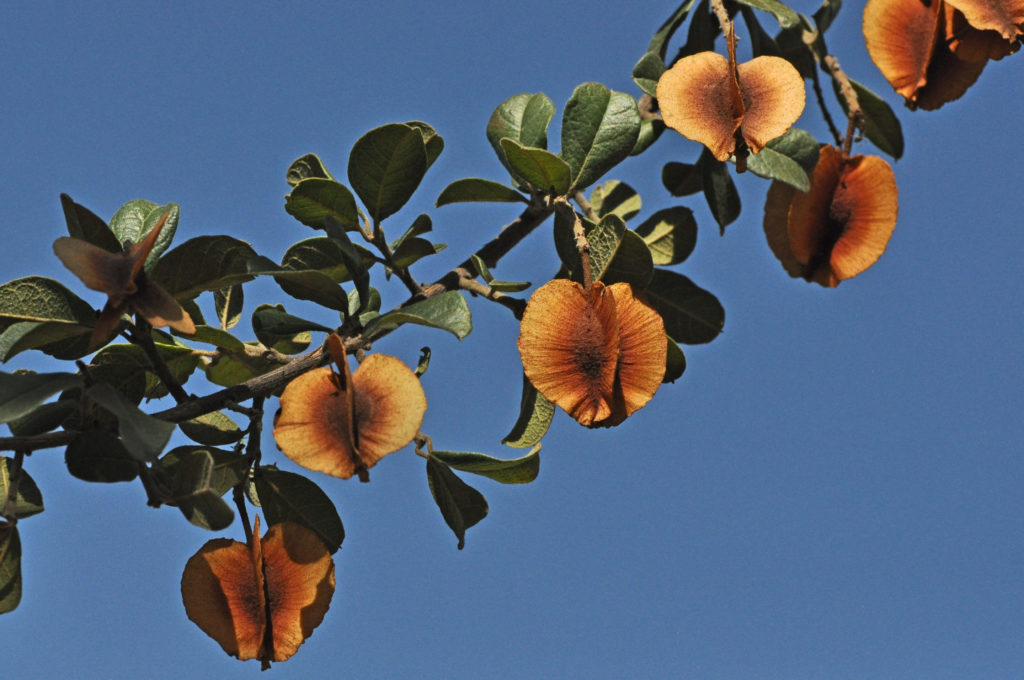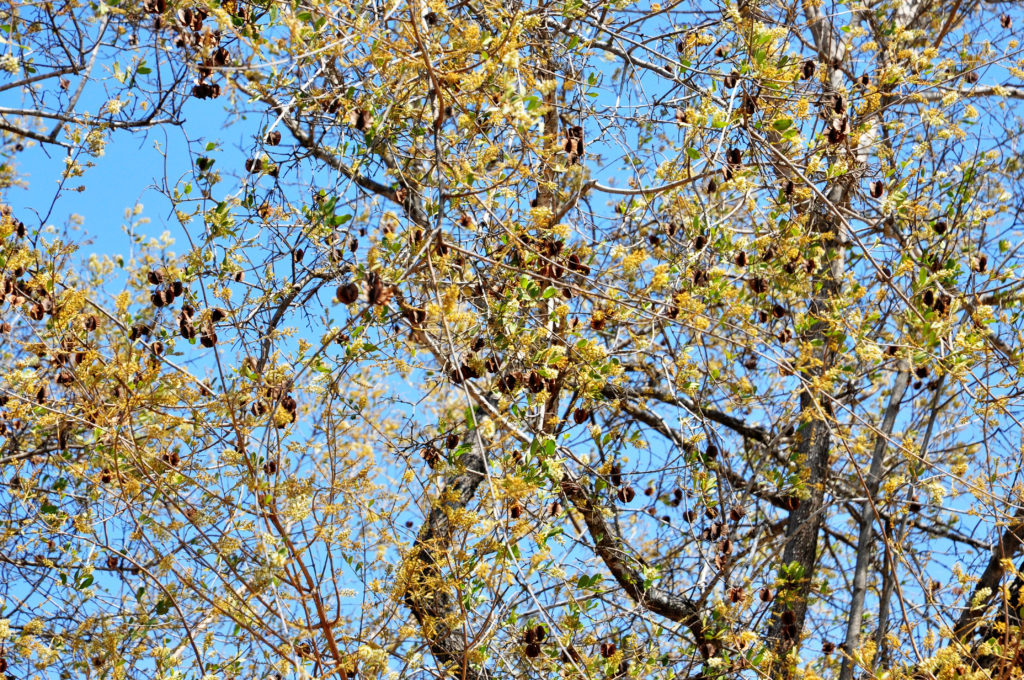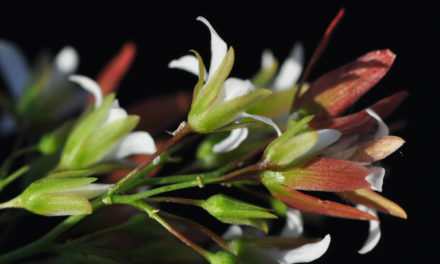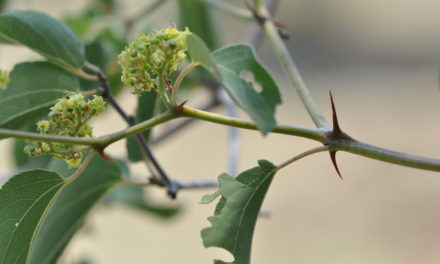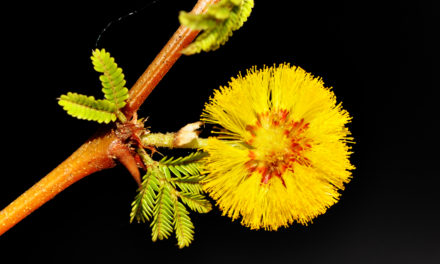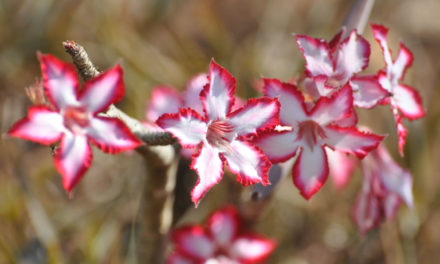General Info – summary
This deciduous Tree with its dense crown and rough, longitudinally fissured, grey to black bark is up to 10m high. Simple, entire and often hairy Leaves lack stipules and rest on hairy petioles. The small, white or creamy yellow, bisexual, regular Flowers with inferior ovaries occur in spikes and lack pedicels. The 8 stamens develop after the stigma and style. The colourful 4-winged and indehiscent Fruit is one seeded.
Description
Previous Names: Combretum hereroense var. villosisimum, Combretum porphyrolepis, Combretum rhodesicum, Combretum transvaalense.
SA Tree No. 538.
Common names: (Afr) kierieklapper. (Eng) Mouse-eared Combretum, Russet Bushwillow: (Russet – dark brown with a red-orange tinge: referring to the fruit). (isiZulu) umhlalavane. (Northern Sotho) mokabi, Mokata. (siSwati) lsihlalavane, LiVimbela, siHlavane, Umdvubu, Umphulumbu. (Tshivenda) mugavhi.
Family: Combretaceae (Bushwlillow family). In this family, there are about 16 genera, which contain about 530 species. In South Africa, there are 5 genera and 41 species. Genera with Trees on this website include Combretum, Lumnitzera, Pteleopsis and Terminalia. The simple and usually entire Leaves lack stipules. Flowers are usually bisexual. There are usually twice the number of stamens as sepals or petals. The inferior Ovary has 1 locule and usually only 1 of the ovules develops into a seed. Fruit is usually indehiscent and may be winged or ridged.
Name derivation: Combretum – climbing plants. hereroense – named after the Herero people of Namibia (250 000 in 2013), Botswana and Angola. They speak Otjiherero.
Conservation Status: http://redlist.sanbi.org/ – here no data is available (2024/09.13). However, it appears to be widespread and not threatened. The IUCN Red List (2019) classifies it as Least Concern and Stable.
Tree
This Tree may reach 7m or more in height and is usually single stemmed but may be multi-stemmed. The dense Crown is usually rounded in isolated trees (photo 568) and the Trunk is often crooked. The rough Bark (photos 510 & 539) is light to dark grey or black, longitudinally furrowed and flakes in narrow strips. These strips become visible as the tree ages. The light grey to reddish brown Branches often arch upwards (photo 568). The initially hairy branchlets (photo 499 – under Leaves) become smooth and hairless.
- 568. 2014/09/11. Lower Sabi KNP. Photo: David Becking.
- 510. 2018/04/27. Nylsvley NR. Photo: David Becking.
- 539. 2014/09/11. Lower Sabi KNP. Photo: David Becking.
Leaves
This tree is deciduous or semi deciduous. When viewed from a distance the leafy tree appears shiny. Leaves are dark to grey green above, paler and covered with velvety brown hairs below (especially young leaves) making the whole tree slightly brown. Leaves may also be almost hairless. Leaves are opposite, or nearly so, often arise on short side shoots (photos 553) and are simple (have a single blade, which may have incisions that are not deep enough to divide the leaf into leaflets). Each leathery leaf is elliptic/broadly elliptic or oval to obovate (shaped like a mouse ear with the widest area near the apex – photo 499). Size varies (7-2cm) x (3-1)cm (photo 502). In autumn, leaves turn a coppery/purplish colour. The short tapering, even notched Apex may be incurved (photo 502), may end in a short sharp tip (photo 499) or is apiculate (ending in a short, sharp, flexible point – photo 499). The Base is tapering to rounded. The Midrib and lateral veins are sunken above and protrude below – where they are clearly visible (photo 502). Here the 3-6 pairs of side veins are often hairy and arch and join with others, prior to reaching the margin (photo 505). All veins are clearly visible if the leaf is examined against the sun with the aid of a hand lens (photo 505). The rolled under Margin (photo 499) may be slightly wavy and is entire (with a continuous margin, not in any way indented). The reddish-brown Petiole (leaf stalk) is often hairy and up to 0,6cm long (photo 502). Stipules (basal appendages of the petiole) are absent. Red Scales may be visible on the lower surface.
- 553. 2014/09/11. Lower Sabi KNP. Photo: David Becking.
- 499. 2018/04/27. Nylsvley NR. Photo: David Becking.
- 502. 2018/04/27. Nylsvley NR. Photo: David Becking.
- 505 2018/04/27 Nylsvley NR. Photo: David Becking. Leaf + sun.
Flowers
The small, white or creamy to yellow, scented Flowers are arranged in dense axillary (growing between stem and leaf) positions (photos 555 and 562) or terminal Spikes (simple, indeterminate inflorescence with sessile flowers on a single unbranched stalk – photo 561). The individual open spike may be almost spherical (photo 561) up to 3mm long and may appear in axils of leaf scars. Flowers may appear before (usually) or with the new leaves. The bisexual flowers are actinomorphic (Regular, symmetrical. Flowers are vertically divisible into similar halves by more than 1 plane passing through the axis). The green Sepals (photo 562) are shorter than the small protruding, very thin white Petals (photo 562). The 8 exerted Stamens are in 2 whorls of 4 and have versatile (hung or attached near the middle, and usually moving freely) Anthers that are dorsifixed (attached by or at the back – dorsal side). There is a single Pistil (a unit of the Gynoecium, the female element of the flower, composed of the Ovary, Style and Stigma). The stigma and style are visible on the upper central inflorescence (photo 562). When viewed closely, each flower appears to have a Pedicel (flower stalk). However, what is visible is the completely inferior Ovary giving the impression that that each flower is stalked (photo 562). Also visible here, on the upper spike of younger flowers, are the Stigma and Style, which emerge before the Stamens. (Sep-Nov).
- 555. 2014/09/11. Lower Sabi KNP. Photo: David Becking.
- 562. 2014/09/11. Lower Sabi KNP. Photo: David Becking.
- 561 2014/09/08 Lower Sabi KNP. Photo: David Becking.
Fruit
The small and very attractive 4-winged Fruit is a Samara (a dry, indehiscent winged fruit, with papery wings, that develop from the ovary wall. The numerous fruits are conspicuous in both number and size. The fruit is usually about 2,4 x 2cm (photo 509) but may be slightly longer than wide. It soon develops impressive golden edged wings (photo 507) and a rich dark reddish-brown centre that surrounds the Seed. This turns darker with maturity and may remain on the tree until after the new flowers appear (photo 569). (Jan-Aug).
- 509 2018.04.27 Nylsvley NR. Photo: David Becking.
- 507 2018/04/27 Nylsvley NR. Photo: David Becking.
- 569 2014/08/11 Lower Sabi KNP. Photo: David Becking.
Distribution & Ecology
This drought resistant, Afrotropic Tree is common in the bushveld (a sub-tropical woodland ecoregion of southern Africa), often grows in sand and close to streams and rivers in both the highveld and lowveld. It also occurs in shrublands and with termite mounds. Trees normally occur below 1 500m. They may be found in stony, shallow and brak/brakish soil (alkaline, containing an excess of minerals) as well as sharing open woodland with Colophospermum mopane. These Russet Bushwillow plants are located in Northern KwaZulu-Natal – here they often grow with Senegalia (Acacia) nigressence. They grow in Gauteng, North West, Mpumalanga e.g., near Lower Sabi KNP. Beyond South Africa they are found in Eswatini (Swaziland), Namibia, Botswana, Zimbabwe, widespread in Mozambique, Uganda, Kenya, Ethiopia, Malawi, Tanzania, Southern Angola, Zambia and Somalia. Mammals, including the Nocturnal, Lesser Bushbabies (with big eyes, long tails, large naked and mobile ears), consume small attracted invertebrates and Gum (possibly poisonous) from wounds. Elephant, giraffe, kudu, steenbuck, duiker and impala graze the Leaves. Puffback (Dryoscopus sp.) and other local shrikes are among the birds that are attracted by the insects that pollinate the flowers or eat the fruit. Coppicing (when stems are cut or burned it causes regrowth from the stump or roots) can occur and help survival
Ethnobotany
This reasonably dense Wood is hard, brown and has dark markings. It is termite and borer resistant and produces a good finish. Wood is used to make implement handles like pick and hoe handles as well as knobkerries (using the connection of big and small branches). The wood is an excellent fuel – producing long-lasting coals. The Tree also makes a good bonsai. Leaves provide a useful cattle fodder and dried leaves are used to make tea in Zimbabwe. Seeds within the fruit may last for more than a year, however germination rate is low and young plants should be protected against frost. Prior to planting, the seeds must be removed from the fruit. This slow growing plant does best in sunny or semi-shaded places and in sandy or loamy soils. A good bonsai can be generated with Combretum hereroense. Local medicine makes use of this plant.
References
Boon, R. 2010. Pooley’s Trees of eastern South Africa. Flora and Fauna Publications Trust, Durban.
Burrows, J.E., Burrows, S.M., Lotter, M.C. & Schmidt, E. 2018. Trees and Shrubs Mozambique. Publishing Print Matters (Pty) Ltd. Noordhoek, Cape Town.
Coates-Palgrave, M. 2002. Keith Coates Palgrave Trees of Southern Africa, edn 3. Struik (Pty) Ltd, Cape Town.
Ginn P.J. Mcilleron W.G. and Milstein P. le S, 1989. The Complete Book of Southern African Birds. Struik, Cape Town.
Lawrence, G. H. M, 1951. Taxonomy of Vascular Plants. The Macmillan Company, New York. Tenth Printing 1965.
Palmer, E. & Pitman, N. 1972. Trees of southern Africa. Balkema, Amsterdam, Cape Town.
Schmidt, S. Lotter, M. & McCleland, W. 2002. Trees and Shrubs of Mpumalanga and the Kruger National Park. Jacana, Johannesburg.
van Wyk, B. & van Wyk, P. 1997 Field guide to Trees of Southern Africa. Struik, Cape Town.
http://redlist.sanbi.org
https://en.wikipedia.org/wiki/Combretum_hereroense
http://www.zimbabweflora.co.zw/speciesdata/species.php?species_id=141930
http://iscantree.co.za/combretum-hereroense-kierieklapper-russet-bush-willow/
https://www.iucnredlist.org/search?query=Combretum hereroense&searchType=species

